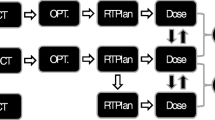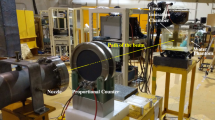Abstract
In this paper an algorithm for calculating 3-D dose distributions within the brain is introduced and adapted to the demands of modern radiosurgery. The dose calculation with this model is based on a 3-D distribution of the primary photon intensity which is calculated with a ray casting algorithm. A prelocated matrix takes into account field sizes as well as modifying elements as collimator positions (MLC), blocks, wedges and compensators. Monte Carlo precalculated monoenergetic kernels from 0.1 MeV to 50 MeV were at our disposal. The components of the spectrum were either determined by deconvoluting depth dose curves measured in water or analyzed with a Ge-Li detector system in the case of60Co. The calculated fluence distribution has to be superposed to the complete kernel containing the spatial energy deposition. Inhomogeneities and tissue interface phenomena (σe, Z) have been investigated. The divergence of the rays and the curved surface of the patient are taken into account. Assuming homogenous media, it is possible to shorten the computation time by using the Fast Fourier Transformation (FFT) delivering a first overview within seconds.The algorithm was evaluated and verified under specific conditions of small fields as used in radiosurgery and compared to dose measurements and Monte Carlo calculations. In using both the fast algorithm (FFT) for mainly homogenous conditions on one hand and the very precise superposition for inhomogeneous cases on the other, this algorithm can be a very helpful instrument especially for critical locations in the skull.
Similar content being viewed by others
References
McNutt, T. R., Mackie, T. R., Paliwal B. R.Analysis and convergence of the iterative convolution/superposition dose reconstruction technique for multiple treatment beams and tomotherapy. Med. Phys., 24(9): (1465–1476), 1997.
Boyer, A., Dosobry, G., Wells, N.Potential and limitations of invariant kernel conformal therapy. Med. Phys., 18(4): (703–712), 1991.
Eklöf, A., Ahnesjö, A., Brahme, A.Photon Beam Energy Deposition Kernels for inverse Radiotherapy Planning. Acta Radiol. Oncol., 29: (447–454), 1990.
Siebers, J. V., Lauterbach, M., Tong, S., Wu, Q., Mohan, R.Reducing dose calculation time for accurate iterative IMRT planning. Med. Phys. 29(2): (231–237), 2002.
Siebers, J. V., Tong, S., Lauterbach, M., Wu, Q., Mohan R.Acceleration of dose calculations for intensity-modulated radiotherapy. Med. Phys., 28(6): (903–910), 2001.
Liu, H.H., McCullough, E.C., Mackie T.R.Calculating output factors for photon beam radiotherapy using a convolution/superposition method based on a dual source beam model. Med. Phys., 24(12): (1975–1985), 1997.
Liu, H. H., McCullough, E. C., Mackie, T. R.Calculating dose and output factors for wedged photon radiotherapy fields using a convolution/superposition method. Med. Phys., 24(11): (1714–1728), 1997.
Mack, A., Mack, G., Weltz, D., Czempiel, H., Kreiner, H.J.Vertification of dose plans using film dosimetry for quality assurance in radiosurgery. D. Kondziolka (ed): Radiosurgery, Basel, Karger, vol 4, pp 213–227, 2002.
Mack, A., Scheib, S., Major, J., Gianolini S., Pazmandi, G., Feist, H., Czempiel, H., Kreiner, H.J.Precicsion dosimetry for narrow photon beams used in radiosurgery — Determination of Gamma Knife output factors. Med Phys 29 (9): 2080–2089, 2002.
Keall, P. J., Hoban, P. W.Superposition dose calculation incorporating Monte Carlo generated electron track kernels. Med. Phys., 23(4): (479–485), 1996.
Murray, D.C., Hoban, P.W., Round, W.H., Graham, I.D., Metcalfe, P.E.Superposition on a multicomputer system. Med. Phys., 18(3): (468–473), 1991.
Ostapiak, O. Z., Zhu, Y., Van, D.Refinements of the finite-size pencil beam model of three-dimensional photon dose calculation. Med. Phys., 24(5): (743–750), 1997.
Aspradakis, M. M., Redpath A. T.A technique for the fast calculation of three-dimensional photon dose distributions using the superposition model. Phys. Med. Biol., 42(8): (1475–1489), 1997.
Bortfeld, T., Schlegel, W., Rhein, B.Decomposition of pencil beam kernels for fast dose calculations in three-dimensional treatment planning. Med. Phys., 20(2): (311–318), 1993.
Bourland, J. D., Chaney, E. L.A finite-size pencil beam model for photon dose calculations in three dimensions. Med. Phys., 19(6): (1401–1412), 1992.
Redpath, A., Twaites, D.A 3-dimensional scatter correction algorithm for photon beams. Phys. Med. Biol., 36(6): (779–798), 1991.
Woo, M., Cunningham, J., Jezioranski, J.Extending the concept of primary and scatter separation to the condition of electronic disequilibrium. Med. Phys., 17(4): (588–595), 1990.
Photon treatment planning collaborative working group.Role of inhomogeneity corrections in three-dimensional photon treatment planning. Rad. Onc. Biol. Phys., 21(1): (59–69) 1991.
Wong, J., Purdy, J.On methods of inhomogeneity corrections for photon transport. Med. Phys., 17(5): (807–814), 1990.
Thomas, S.A modified power-law formula for inhomogeneity corrections in beams of high-energy x-rays. Med. Phys., 18(4): (719–723), 1991.
Condor, J. O’.The density scaling theorem applied to lateral electronic equilibrium. Med. Phys., 11(5): (678–680), 1984.
Iwasaki, A.Calculation of three-dimensional photon primary absorbed dose using forward and backward spread dose distribution functions. Med. Phys., 17(29): (195–202), 1990.
Liu, H. H., McCullough, E. C., Mackie, T. R.Calculating dose distributions and wedge factors for photon treatment fields with dynamic wedges based on an convolution/superposition method. Med. Phys., 25(1): (56–63), 1998.
Lydon, J.M.Photon dose calculations in homogeneous media for treatment planning system using a collapsed cone superposition convolution algorithm. Phys. Med. Biol. 43(6): (1813–1822), 1998.
Arnfield, M. R., Siantar, C. H., Siebers, J., Garmon, P., Cox, L., Mohan, R.The impact of electron transport on the accuracy of computed dose. Med. Phys., 27(6): (1266–1274), 2000.
Mack, A.Entwicklung von Verfahren zur Optimierung der räumlichen Dosisverteilung in der Therapie mit hochenergetischen Photonenstrahlenbündeln. PhD Thesis, University of Tübingen, 1996.
Mackie, T., Bielajew, A., Rogers, W., Battista, J.Generation of photon energy kernels using the EGS Monte Carlo Code. Phys. Med. Biol., 33: (1–20), 1988.
Liu, H. H., McCullough, E. C., Mackie, T. R.A dual source photon beam model used in convolution/superposition dose calculations for clinical megavoltage x-ray beams. Med. Phys., 24(12): (1960–1974), 1997.
Liu, H.H., McCullough, E.C., Mackie, T.R.Correcting kernel tilting and hardening in convolution/superposition dose calculations for clinical divergent and polychromatic photon beams. Med. Phys., 24(11): (1729–1741), 1997.
Metcalfe, P., Hoban, P., Murray, D., Round, W.Beam hardening of 10MV radiotherapy X-rays; analysis using a convolution/superposition method. Phys. Med. Biol., 35(11): (1533–1549), 1990.
Treuer, H., Boesecke, R., Schlegel, W.The source-density function: determination from lateral dose distributions and use for convolution dosimetry. Phys. Med. Biol., 38: (1895–1993), 1993.
Ahnesjö, A., Trepp, A.Acquisition of the effective lateral energy fluence distribution for photon beam dose calculations by convolution models. Phys. Med. Biol., 36 (7): (973–985), 1991.
Sauer, O.Dosisverteilungen an Material-Grenzflächen bei energiereichen Röntgenstrahlen. Dissertation, Universität Würzburg, 1994.
Werner, B.Dose perturbations at interfaces in photon beams: Annihilation radiation. Med. Phys., 18: (713–718), 1991.
Sharpe, M. B., Battista, J. J.Dose calculations using convolution and superposition principles: the orientation of dose spread kernels in divergent x-ray beams. Med. Phys., 20(6): (1685–1694), 1993.
Ahnesjö, A., Andreo, P.Determination of effective bremsstrahlung spectra and electron contamination for photon dose calculations. Phys. Med. Biol., 34: (1451–1464), 1989.
Chui, C., Mohan, R.Extraction of pencil beam kernels by the deconvolution method. Med. Phys., 15(2): (138–144), 1988.
Sauer, O., Neumann, M.Reconstruction of high-energy bremsstrahlung spectra by numerical analysis of depth dose data. Rad. and Onc., 18: (39–47), 1990.
Boyer, A., Wackwitz, R., Mok, E.A comparison of the speeds of three convolution algorithms. Med. Phys., 15(2): (224–227), 1988.
Butts, J. R., Foster, A. E.Comparison of commercially available three-dimensional treatment planning algorithms for monitor unit calculations in the presence of heterogeneities. J. Appl. Clin. Med. Phys., 2(1): ( 32–41). 2001.
Boyer, A., Zhu, Y., Wang, L., Francois, P.Fast Fourier Transform convolution calculations of x-ray isodose distributions in homogeneous media. Med. Phys., 16(2): (248–253), 1989.
Miften, M., Wiesmeyer, M., Monthofer, S., Krippner, K.Implementation of FFT convolution and multigrid superposition models in the FOCUS RTP system. Phys. Med. Biol., 45(4): (817–833), 2000.
Murray, D. C., Hoban, P. W., Metcalfe, P. E., Round, W. H.3-D superposition for radiotherapy treatment planning using fast Fourier transforms. Australas Phys. Eng. Sci. Med., 12(3): (128–137), 1989.
Zhu, Y., Boyer, A.X-ray dose computations in heterogeneous media using 3-dimensional FFT convolution. Phys. Med. Biol., 35(3): (351–368), 1990.
Schulze, C.,3-D-Dosisberechnung(II)-Inhomogenitatskorrekturen. 3-D-Workshop 95, DKFZ Heidelberg: (73-88), 1995.
Author information
Authors and Affiliations
Corresponding author
Rights and permissions
About this article
Cite this article
Mack, A., Weltz, D., Scheib, S.G. et al. Development of a 3-D convolution / superposition algorithm for precise dose calculation in the skull. Australas. Phys. Eng. Sci. Med. 29, 1 (2006). https://doi.org/10.1007/BF03178822
Received:
Accepted:
DOI: https://doi.org/10.1007/BF03178822




